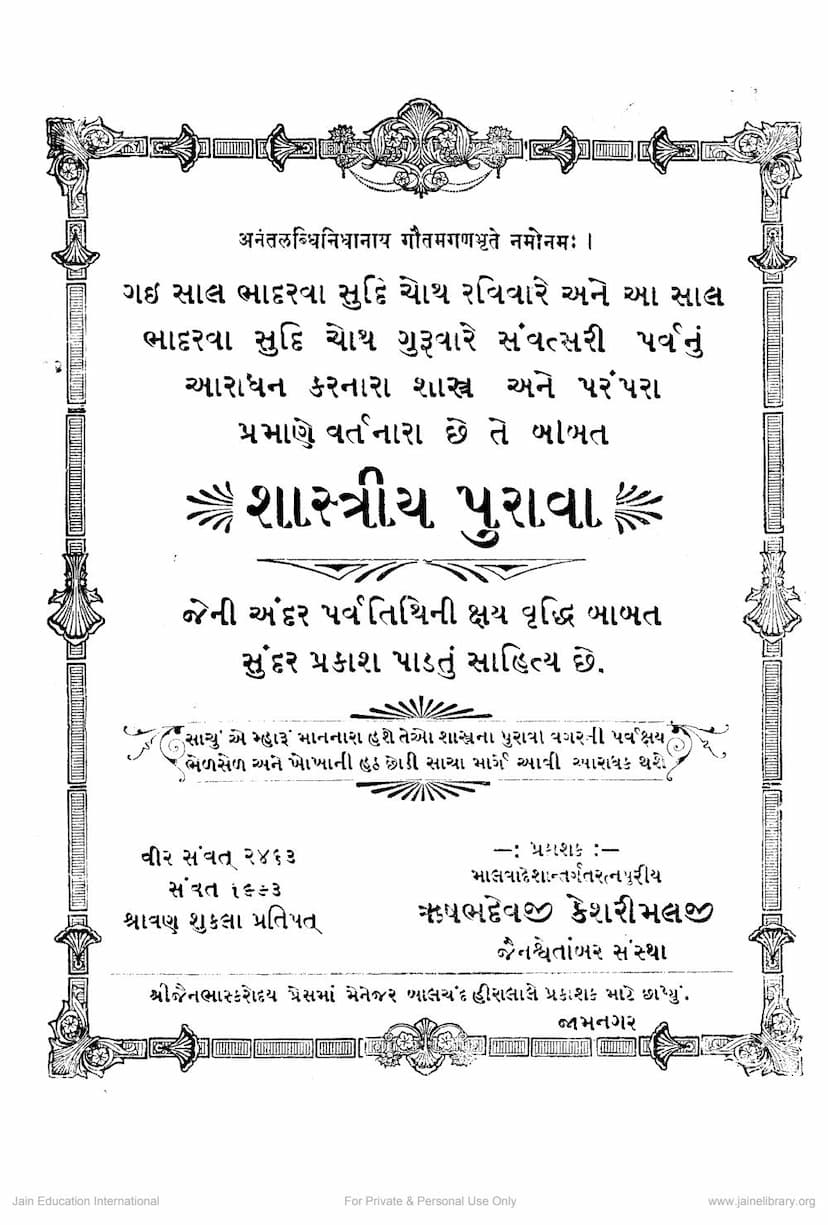Shastriya Purava
Added to library: September 2, 2025

Summary
The book "Shastriya Purava" (Classical Evidence) published by Rushabhdev Keshrimal Jain Shwetambar Sanstha, Ratlam, addresses a significant debate within Jain tradition regarding the determination of festival dates, specifically the timing of the Paryushan festival and its associated observances. The central issue revolves around the concept of Kshaya (reduction) and Vruddhi (increase) of tithis (lunar days) and how these affect the celebration of important festivals.
The book presents a compilation of ancient Jain texts and commentaries, highlighting various manuscripts and their interpretations by respected scholars and acharyas (preceptors). The core argument is that while popular or calendrical calculations might suggest adjusting festival dates due to tithi fluctuations, the authentic Jain scriptures and traditions mandate adherence to specific principles that prevent the alteration of the tithi of parva (festival) days.
Key Arguments and Evidence Presented:
- Consistency in Festive Tithis: The book emphasizes that according to Jain Agamas (scriptures), a parva tithi (festival lunar day) should neither be reduced nor increased.
- Handling of Kshaya (Reduction):
- When a parva tithi experiences kshaya, the preceding tithi is to be observed.
- Specifically concerning the full moon (Purnima) and new moon (Amavasya), if they experience kshaya, then the thirteenth lunar day (Terash) also experiences kshaya.
- Similarly, if the fifth lunar day of the bright half of the month of Bhadrapada (Bhadra Sud Panchami) experiences kshaya, then the third lunar day of the same month (Tritiya) also experiences kshaya.
- Handling of Vruddhi (Increase):
- When a parva tithi experiences vruddhi, the preceding tithi is doubled or observed twice.
- Following the principle of kshaya, if Purnima or Amavasya has vruddhi, then Terash also has vruddhi.
- If Bhadra Sud Panchami has vruddhi, then Tritiya also has vruddhi.
- Emphasis on Proper Observance: The book stresses that the actual observance and rituals associated with these festivals, such as Paakshik Pratrikraman (a specific ritual performed during the fortnight) and Samvatsari (the main Jain festival), should be performed on the tithi prescribed by the scriptures, even if there are perceived discrepancies in popular calendars.
- Scholarly Support: The book cites various sources, including the works of esteemed scholars like Upadhyaya Shri Vinayvijayji, Pandit Roopvijayji, Pandit Mohanvijayji, and others. It references specific manuscripts dating back centuries, providing textual evidence for these interpretations.
- Critique of Alternative Interpretations: The book implicitly or explicitly critiques interpretations that prioritize popular calendrical adjustments over scriptural dictates. It argues that deviating from established traditions and scriptures can lead to confusion and deviation from the true path.
- The Case of Paryushan and Samvatsari: The book specifically addresses how these principles apply to the Paryushan festival. It clarifies that if Bhadra Sud Panchami has vruddhi, then Tritiya should also have vruddhi, and if it has kshaya, then Tritiya should have kshaya. The text aims to establish the correct day for celebrating Samvatsari, arguing that the traditional practice of observing it on a specific day (in this context, a Thursday, based on the year of publication) is supported by scriptural evidence and tradition.
Core Conclusion:
The overarching conclusion of "Shastriya Purava" is to uphold the sanctity and authority of Jain scriptures and traditions concerning the determination of festival dates. It advocates for a strict adherence to the principles of tithi calculation as laid down by ancient acharyas, emphasizing that perceived calendar anomalies should not lead to the alteration of festival observances. The book serves as a defense of traditional Jain practices against what it deems as potentially erroneous popular interpretations, aiming to guide the community towards correct religious observance.
The book is essentially a scholarly treatise providing scriptural and traditional backing for specific methods of calculating and observing Jain festivals, particularly highlighting the unchanging nature of the festival tithis as per the core Jain teachings.